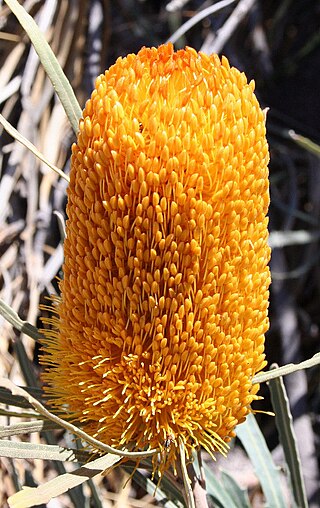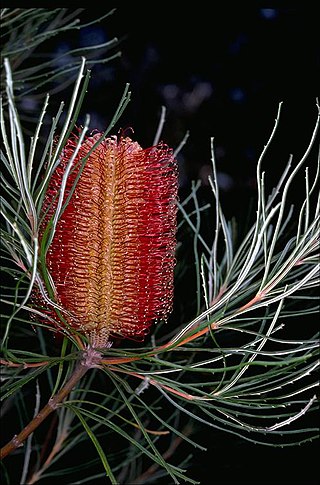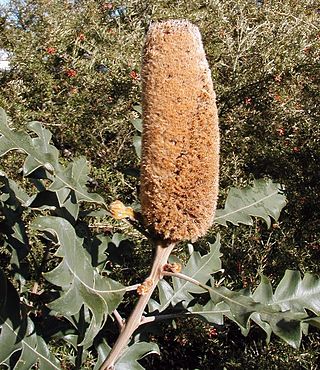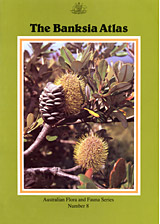
Albany banksia refers to two shrubs endemic to southwestern Australia, named after the town of Albany.

The Atlas of Australian Birds is a major ongoing database project initiated and managed by BirdLife Australia to map the distribution of Australia's bird species. BirdLife Australia is a not-for-profit bird research and conservation organisation.

Banksia baxteri, commonly known as Baxter's banksia or bird's nest banksia, is a species of shrub that is endemic to Western Australia. It has greyish brown bark, hairy stems, deeply serrated leaves with triangular lobes and lemon-yellow flowers in an oval flower spike that grows on the end of branches.

Banksia benthamiana is a species of shrub that is endemic to the Southwest of Western Australia. It has hairy, linear leaves, usually with scattered small teeth along the edges, and spikes of orange flowers.

Banksia chamaephyton, commonly known as the fishbone banksia, is a species of shrub that is endemic to Western Australia. It has prostrate, underground stems, pinnatipartite leaves, cream-coloured and brown flowers arranged in spikes surrounded by hairy bracts. It grows in kwongan near the lower west coast.

Banksia laevigata, commonly known as the tennis ball banksia, is a species of shrub that is endemic to Western Australia. It has serrated, broadly linear to narrow wedge-shaped leaves, yellow or yellowish green flowers, depending on subspecies, and linear to elliptic follicles with a slightly wrinkled surface.

Banksia lanata is a species of shrub that is endemic to a restricted area of Western Australia. It has linear leaves, pale cream-coloured flowers in a head with whitish bracts at the base and later up to fifty elliptical follicles in each head.

Banksia laricina, commonly known as the rose banksia, is a species of shrub that is endemic to southwestern Western Australia. It has crowded, linear leaves with a short point on the tip, golden brown flowers with a bright yellow style and prominent egg-shaped follicles.

Banksia occidentalis, commonly known as the red swamp banksia, is a species of shrub or small tree that is endemic to the south coast of Western Australia. It has smooth bark, linear, sparsely serrated leaves, golden flowers in a cylindrical spike, and later up to sixty follicles in each spike.

Banksia pilostylis is a species of shrub that is endemic to the south-west of Western Australia. It has hard, fissured bark, narrow wedge-shaped, serrated leaves, pale yellow flowers in cylindrical spikes and elliptical follicles that open when heated in a bushfire.

Banksia solandri, commonly known as Stirling Range banksia, is a species of large shrub in the plant genus Banksia. It occurs only within the Stirling Range in southwest Western Australia. Its scientific name honours the botanist Daniel Solander, one of the first collectors of Banksia.

Banksia tricuspis, commonly known as Lesueur banksia or pine banksia, is a plant in the family Proteaceae and is endemic to a small area in the south-west of Western Australia. It is a stunted tree or shrub with narrow leaves and cylindrical spikes of golden-coloured flowers and it occurs in a geographic range of just 15 square kilometres near Jurien.
Stephen Donald Hopper AC FLS FTSE is a Western Australian botanist. He graduated in Biology, specialising in conservation biology and vascular plants. Hopper has written eight books, and has over 200 publications to his name. He was Director of Kings Park in Perth for seven years, and CEO of the Botanic Gardens and Parks Authority for five. He is currently Foundation Professor of Plant Conservation Biology at The University of Western Australia. He was Director of the Royal Botanic Gardens, Kew from 2006 to 2012.

Banksia sect. Oncostylis is one of four sections of subgenus Banksia subg. Banksia. It contains those Banksia species with hooked pistils. All of the species in Oncostylis also exhibit a top-down sequence of flower anthesis, except for Banksia nutans which is bottom-up.

Banksia ser. Spicigerae is a taxonomic series in the genus Banksia. It consists of the seven species in section Oncostylis that have cylindrical inflorescences. These range in form from small shrubs to tall trees. The leaves grow in either an alternate or whorled pattern, with various shape forms. The Spicigerae inflorescence is held erect, subtended by a whorl of branchlets, and retains a regular pattern until anthesis. The perianth limb is horizontal until anthesis, at which point the perianth opens from underneath. The pollen-presenter is ovoid or conical. The seed wings are not notched.

Banksia sect. Banksia is one of four sections of Banksia subgenus Banksia. It contains those species of subgenus Banksia with straight or sometimes curved but not hooked styles. These species all have cylindrical inflorescences and usually exhibit a bottom-up sequence of flower anthesis. It is a widely distributed section, with taxa occurring in both the south west and east coastal distributions of the genus.

Banksia audax is a species of shrub that is endemic to Western Australia. It has fissured, grey bark, woolly stems, hairy, serrated leaves and golden orange flower spikes.

Banksia micrantha is a species of small shrub that is endemic to the south-west of Western Australia. It is a spreading bush with sharply-pointed linear leaves, pale yellow flower spikes and up to twenty-five follicles surrounded by the remains of the flowers. It was first formally described by Alex George in 1981.

Banksia lullfitzii is a species of shrub that is endemic to the south-west of Western Australia. It has linear leaves with widely-spaced, sharply-pointed teeth on the sides, golden-orange to orange-brown flowers, and later, up to thirty follicles in each head.

Banksia laevigata subsp. laevigata, the tennis ball banksia, is a subspecies of small woody shrub in the plant genus Banksia. It occurs in Western Australia's semi-arid shrubland. It and the closely related B. laevigata subsp. fuscolutea are the two subspecies of the species Banksia laevigata.



















